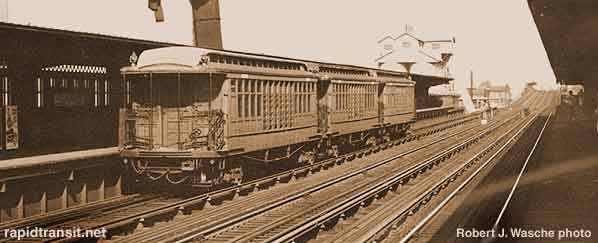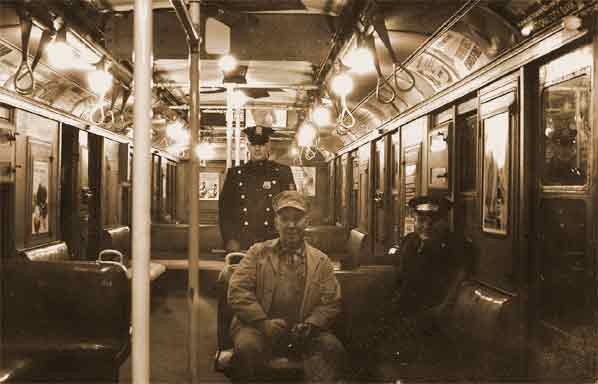
July 2000 / Looking Back to 1975
BMT Culver Shuttle
Closes
by Paul
Matus (The Third Rail
, April-June 1975)
Beginning with city operation in June 1940, the subway system's municipal operators relentlessly abandoned services large and small. The tide against abandonment turned slowly, and the Culver Shuttle, which might have provided a useful alternative route, may have been the last to fall.

Elevated
shuttles of "BU" gate cars operated between Ninth Ave. and Coney
Island via the Culver Line during rush hours, in addition to the regular
subway service. This operation lasted from city ownership in 1940 until
June 20, 1952. A train of 1300 series convertible cars is shown at 13th
Ave. station (on what became the Culver Shuttle) during the last days of
el car operation. Side panels on these cars could be removed during the
hot months to provide a delightfully cool ride. Robert J. Wasche
photo.
Copyright 1975 Third Rail Press.
Reprinted by permission.
Copyright 2000 The Composing Stack
Inc.
"Last runs" aren't the commonplace event they were
just a few short years ago. Part of the reason lies in the fact that there
are so many fewer lines to provide candidates for closure. Another part is
that most cities have recognized the value of their remaining rail service
and have taken steps to retain it.
So, when
a closing takes place today—even a small closing—it's worth looking
at.
Just after midnight, Sunday, May 11, 1975,
the tiny BMT Culver Shuttle, a bare mile of single track elevated
connecting the BMT West End Line at 9th Avenue station in Brooklyn's
Borough Park section with the IND Culver Line at Ditmas and McDonald
Avenues, closed down after more than 55 years of service on the structure,
which replaced the original surface line on March 16,
1919.
The wonder is not that New
York's MTA closed the decayed line—rather it is that it took so long to strike the
final blow.
The decline of the Culver
Shuttle began on the day it was created: October 30, 1954. On that day,
the City of New York realized its long-time goal of extending Concourse
"D" IND train service to Coney Island via the formerly BMT Culver Line. By
so doing, the city's then-longest subway run--26 miles-was created, and
easy access to Coney Island train service was provided for millions of IND
riders.
The service was put into effect by
constructing a ramp from the Church Avenue station of the IND's Brooklyn
Line to connect with the Culver Line at Ditmas Avenue. At the same time a
single stub-end track was constructed on the west side of the Ditmas
Avenue platform. All track connections between the IND and BMT were broken
at this point and BMT service ended on the little stub
track.
Initially, approximately the same
service was maintained on the shortened BMT Culver Line as existed before
the change. Culver Locals continued to operate between Ditmas Avenue and
Chambers Street under the Municipal Building in Manhattan during midday hours
on weekdays, and Culver Expresses made their fast rush hour run from
Ditmas Avenue through the Nassau Street loop in the financial district and
back to Brooklyn. Only during late evening, night, and weekend hours did
Culver trains shuttle between Ditmas Avenue and a connection with the
three Fourth Avenue subway services at 36th
Street.
As the new service was less attractive
to riders than the old, the BMT's Culver operation lost passengers until,
on May 28, 1959 the "May Massacre" round of service cuts brought the
shuttle down to its final four-stop operation.
The shuttle operation was virtually a lesson in how to drive away
passengers. During the late-night hours, when connecting West End Line
service was also reduced to a shuttle, a hypothetical rider who wanted to
travel just three stops from 25th Street on the Fourth Avenue Line to Fort
Hamilton Parkway on the Culver Line would have had to take three separate
trains where previously he could have taken one - and no connections
guaranteed!
The best joke on the rider was at
the Ditmas Avenue connection with the IND operation. An electric contact
at the 13th Avenue Station turned on "hold" lights so that IND trains
could wait for shuttle passengers who wanted to continue their journeys
southward. Unfortunately, another contact turned off the lights just as
the shuttle pulled in for the connection. If shuttle riders had a token
for every time that the IND train closed its doors a second before the
shuttle stopped ...
Deterioration continued
as the northbound local track was ripped up and the signals were removed
(who needed signals with only one train on the line?). By 1965 abandonment
rumors were common. As winter's cold closed in, the word was that the line
would close "in May." That rumor turned out true, but nine years
late.
In its last days the shuttle presented a
shabby sight. Concrete platforms installed elsewhere on the system never
came to the Culver Shuttle, and the old wood platforms just grew older and
more warped daily. The last trains crawled along at low speeds, either for
safety's sake or as a demonstration of the MTA's attitude toward the line.
As a kind of small, final insult, the line's third rail was laid bare to
the elements, never having received the wood covers installed everywhere
else in the city.
Some things won't be changed
by the Culver Shuttle's demolition: The original Culver Line, operating on
the surface beneath the structure and known as the South Brooklyn Railway,
will continue to carry freight trains between Bush Terminal and Coney
Island, and old Italian men will continue to use the space between the
rails of that line to play bocce, a bowling game. Every now and then they
may look up on a sunny day and remember the shade they once received from
the el that was a part of the neighborhood.

Crew 3, Passengers 0. Culver Shuttles often ran
empty during the small hours of the morning. Here the entire crew of the
shuttle (motorman, conductor and patrolman) poses for the cameraman at 3
a.m. during December 1965. Paul Matus photo
It took another decade before they came around to tearing down the Culver Shuttle.
Read about it in Culver's Travels at Kevin Walsh's forgotten-ny.com
The Third Rail and The Third Rail logo are trademarks of The Composing Stack Inc..
Return to The Third Rail Online Home
Return to
rapidtransit.net Home
Everything on this site is copyright © 2000 by The Composing
Stack Inc., except as otherwise noted.
Materials
with other copyrights are used by permission.
All
rights reserved
Last updated